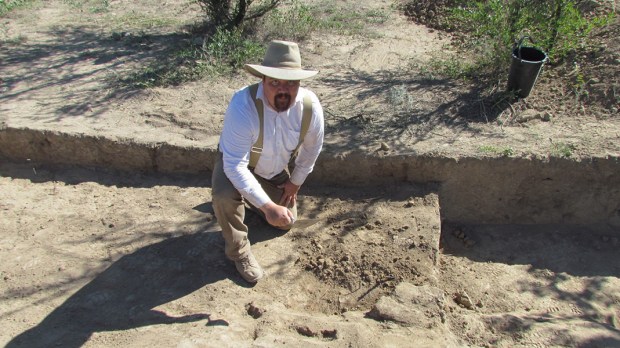“It was exciting to be on a team that discovered an entire lost city,” said Charles A. Stewart, a Catholic Indiana Jones, digging into ancient worlds to find sacred history and then sharing it with his students.
I was watching the documentary Christians of the East – The Untold Story Along the Silk Road (watchable on YouTube, see below), which tells the incredible story of how we have learned that Christianity reached China as early as the year 635 and was well established Eurasia in ways lost to history, and wondering why I hadn’t heard more about it.
At first I thought it was a typo that called him an art historian at Benedictine College, where I work, but soon met him for the first time — and talked to his students.
Stewart may not have had to dispatch villains with a whip like Indiana Jones, but his discoveries are just as amazing: A lost city halfway between Constantinople and Beijing; ancient Christian symbols in a long-forgotten graveyard; and the roots of a Christian civilizations whose history was erased by invaders.
The story includes notorious villains, including Genghis Khan (1162-1227) and the Black Death itself. It also has dashing heroes from Italian explorer Marco Polo to the legendary King Prester John who was rumored in medieval Europe to rule over a Christian land to the east that had survived pagan and Muslim aggressors.
A lost city is found
The city that Stewart’s team found is halfway between modern Istanbul and Beijing, and it is part of larger series of discoveries.
“Historical documents described a city over 700 years ago called Ilibalyk, or ‘City along the Ili River,’ which was a major center on the Silk Road,” Stewart said. “Ilibalyk disappeared 600 years ago without a trace.”
“Our research was able to uncover the historical sources that matched the archaeological remains,” he said. “It’s exhilarating when all the data, from different sources, across several continents, lines up so well.”
Evidence of the early spread of Christianity to the East
These findings rewrite Christian history to show the full extent to which the faith was moving east from Palestine at the same time it was moving west to Europe and the New World.
In 2018 an exciting discovery was of a graveyard in the lost city with men, women and children buried with heads propped up to look east for the coming of Christ.
Stewart’s students have been fascinated to learn of one symbol found at the cemetery: the rosette.
“Wearing the rosette was a way for Christians to express their religion without others knowing that they are Christians unless they knew the meaning of the rosette,” said Emma Schwartz, a first-year student from Plano, Texas.
Stewart explains that the symbol of the four-petaled rosette flower comes from ancient Egypt.
“This symbol had actually two meanings; when it’s in the sky it’s a symbol of a star,” he said. “In a sense you can say that a star is a flower in the sky and a flower is a star on the earth.”
Stewart said that the symbol shows a sophisticated Christian commitment. “Both flowers and stars are symbols of beauty and beauty itself is a symbol of an underlying transcendent spiritual reality that the ancients were always in search of,” he said.
But the rosette is a secret symbol of something else: the negative space between the four petals forms a cross.
In the documentary, Stewart traces the surprising history of cross imagery from St. Helena, the mother of Constantine, to the gravesites found in Ilibalyk.
The crosses found on gravestones at the lost city show another dimension of the Christianity of these people. At a time when the cross was a “new” symbol of Christianity, “I believe the Christians living in Ilibalyk chose this particular type of cross as an expression of their faith because they’re actually emphasizing the historicity of Christianity,” he said.
Jane Spencer, a senior from Granville, Missouri, appreciates how Stewart’s work helps students understand the faith.
“He especially emphasizes, for example, how newly uncovered ancient art proves more and more that religious worship is a fundamental part of being human, debunking the popular materialistic interpretations of early man,” she said. “I appreciate Dr. Stewart’s enthusiasm, and his rational, clear defense of Christianity’s role in history.”
“The study of Christian history and art is actually part of my journey of my faith,” Stewart said. But the objectivity of his scholarship has been respected by both Christians and non-Christians.
“I have always been open about my research goals — and I always distinguish between scientific, historical facts from mere speculation and opinion.”
It is a bit like having a class with Indiana Jones, according to Cathryn Schneider, a senior from St. Paul, Minnesota. “I love that he has been to all or many of the places he teaches about. “

